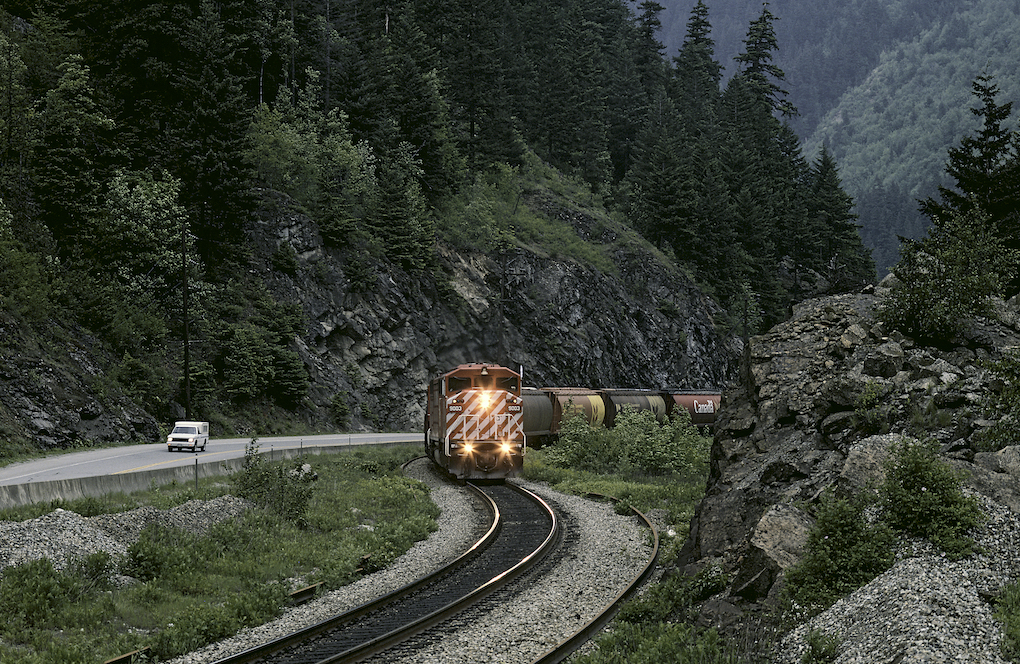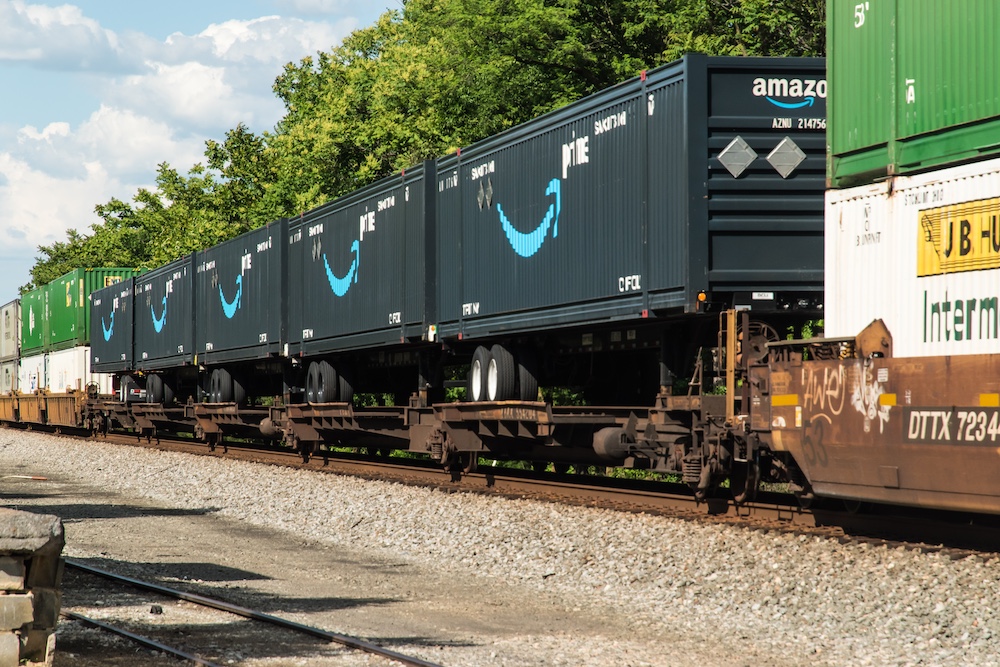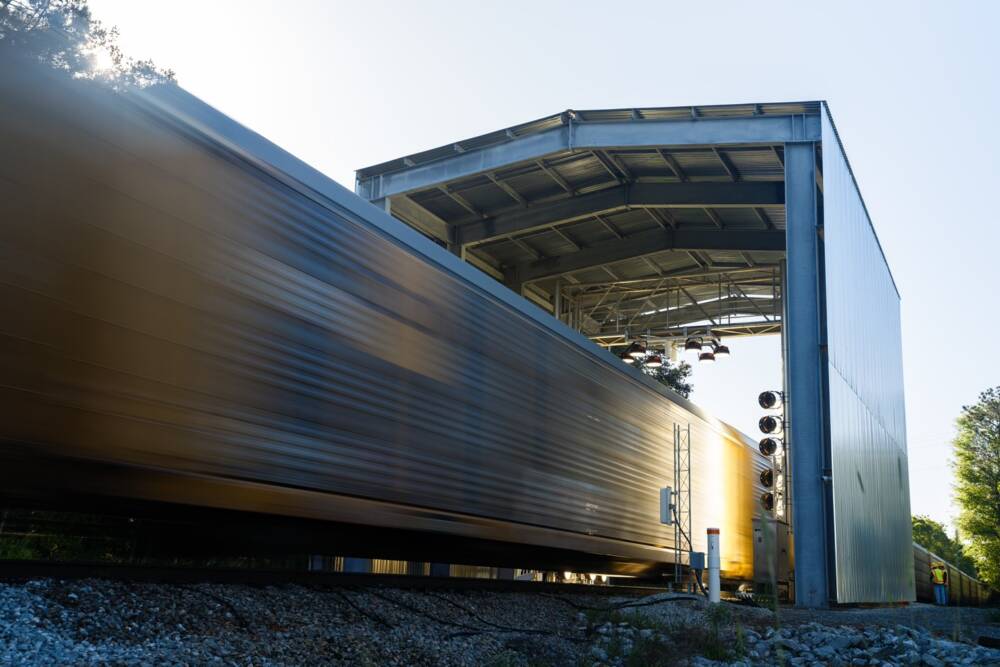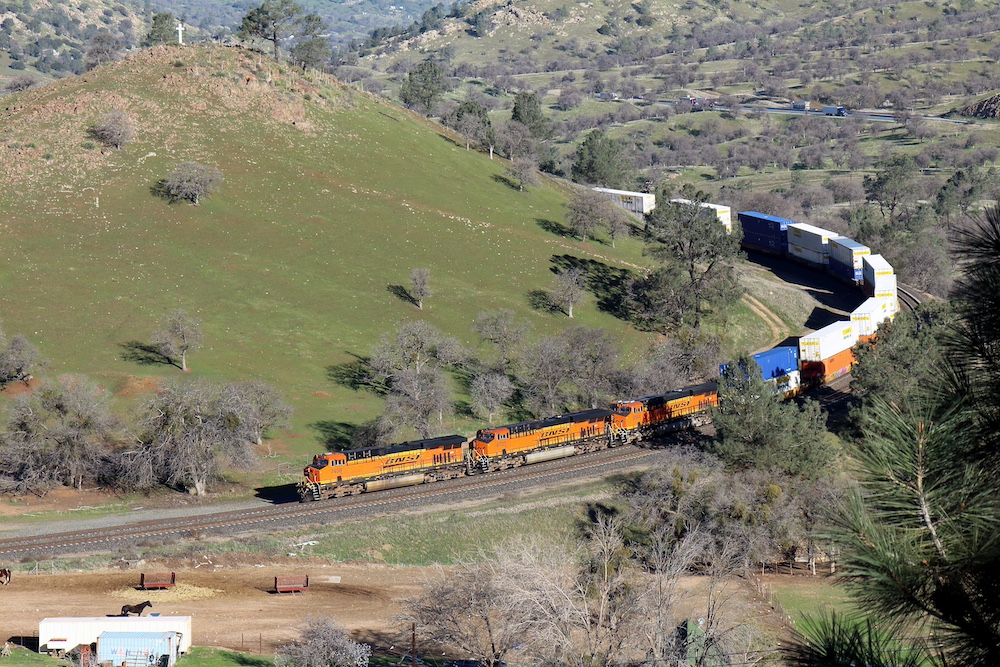The first is the joint rate and route. Two railroads, by agreement, establish one rate from an origin on the first to a destination on the second. One of the railroads sends the one bill, the shipper returns one check, and the billing railroad pays the other its share, or “division,” of the revenue. Each railroad remains individually responsible for providing locomotive and crews for movement over its lines and for loss and damage to the freight while in its possession.
The second method is trackage rights. Here one railroad (the “tenant” line), by agreement, secures the right to operate its trains, typically with its crews, over the track of a second railroad (the “owner”). The trackage used by both railroads is called a “joint facility.”
Trackage rights
In contrast with joint routes and rates, under a trackage-rights agreement, the tenant railroad is solely responsible to the shipper for providing transportation service over the joint facility and for loss and damage to the freight.
The owner is compensated through the tenant’s payment of a fixed annual sum for the right to use the joint facility plus a variable fee – based on the proportion of the tenant’s traffic relative to the total traffic over the joint facility – to compensate it for track maintenance, train dispatching, and other such expenses.
For accounting simplicity, the majority of recent trackage-rights agreements state the tenant line’s charge in terms of cents per car-mile or ton-mile.
Trackage rights can be “full service,” meaning that the tenant has the right to serve shippers on the joint facility directly, or “overhead” or “bridge” (the terms are synonymous), meaning that the tenant cannot carry freight to and from the owner’s customers. Union Pacific’s rights over Burlington Northern Santa Fe’s Cajon Pass line are an example of full service trackage rights. The vast majority, however, permit the tenant to move only bridge traffic.
In the current deregulated environment, both methods have their disadvantages. The Staggers Act of 1980 greatly reduced the antitrust immunity that protected competing railroads when setting joint rates, while shippers disliked having to bargain with more than one carrier when negotiating one of the newly permitted transportation contracts. Trackage rights agreements, meanwhile, are regulated by the Surface Transportation Board and thus are matters of public record.
Also, traditional employee protection obligations attach to trackage rights. If the employees of a landlord lose work, or their jobs, because a new tenant takes away traffic, they are entitled by federal law to up to six years’ pay.
Haulage rights
To avoid these pitfalls, railroads increasingly have turned to haulage arrangements, which separate a railroad’s marketing and operating functions.
The railroad receiving haulage rights gets control of marketing. It negotiates the rate or contract with the customer over the entire route. It also supplies the cars and is on the hook for loss and damage.
The railroad granting the haulage rights, meanwhile, retains direct control over operations. It provides the track, train crews, dispatching services, and sometimes the locomotives. In return, the host railroad gets a cents-per-unit payment for each car moved, but it isn’t privy to the haulage road’s deals with the shippers.
Shippers like haulage because it centers responsibility for the whole movement, from origin to destination, on just one railroad. There’s no complicated haggling with a chain of carriers when the customer wants to change rates or service.
Railroads like the concept because, under a series of federal and court decisions, haulage has been held to be a commercial arrangement outside the STB’s trackage rights jurisdiction. That means host railroad employees don’t get labor protection – most of the time, they benefit from the additional traffic the haulage road generates – and the railroads do not have to publicly report the terms of their haulage contracts. Secrecy results in confusion over matters such as the location of interchanges and responsibility for car hire – making haulage a sore point for industry accountants – but railroads understandably don’t want to tell all about their market advantages.
Confusion over haulage rights is understandable. Professional railroaders themselves are often befuddled by the multitude, complexity, and variety of the haulage arrangements which have proliferated over the past decade.
Santa Fe’s route map from 1994 illustrates how one railroad used the haulage concept to expand its commercial influence from coast to coast. The map shows not just the 7600 route-miles Santa Fe operated directly, but at least that many more miles under haulage arrangements. Santa Fe marketed intermodal service to Boston, New York, and Philadelphia through a haulage agreement with Conrail dating back to 1988. Under a haulage agreement with Grand Trunk Western, Santa Fe provided single-line service for trailer-loads of auto parts moving from manufacturers in Mexico to Ford vehicle assembly plants in Ontario. Another agreement with Gateway Western permitted Santa Fe to quote rates to and from St. Louis. In 1993 Santa Fe commenced service to Memphis and Birmingham via haulage service over Burlington Northern. A haulage agreement also was in effect with the Arizona & California Railroad, a regional carrier spun off by Santa Fe in 1991. Santa Fe even extended the haulage concept to motor carriers, which carried intermodal loads under the Santa Fe banner to points as diverse as Winston-Salem, N.C., and Sacramento, Calif.
Outsiders’ confusion over how and where railroads serve their customers isn’t likely to end soon, since haulage rights will continue to be a useful tool for addressing the railroads’ evolving marketing needs.














yesil damla
twitter beğeni satın al alırken önce istediğiniz pakete karar vermeli ve ardından iletişim bilgilerinizi sisteme girmelisiniz. Twitter uygulaması en çok tercih edilen sosyal medya hizmetlerinden birisidir.
steel man
instagram düşmeyen takipçi satın al
instagram takipçi satın al
Reinigungsfirmen
Minimalizm nedir? Sorusuna kısaca; ‘sadeliğe dayanan bir akım’ olarak cevap verebiliriz.
mavi tur
Hausreinigung Basel
ip tv satış
ip tv satış
ucuz iptv
iptv satın al
ucuz iptv
donmayan iptv
iptv abonelik
iptv
iptv
takipçi satın al
takipçi satın al
takipçi satın al
takipçi satın al
takipçi satın al
Bulvar Gazete
takipçi satın al
takipçi satın al
takipçi satın al
takipçi satın al
takipçi satın al
takipçi satın al
takipçi satın al
tiktok takipçi satın al
ucuz takipçi satın al
takipçi satın al
instagram takipçi satın al
tiktok takipçi satın al
takipçi satın al
instagram takipçi satın al
instagram takipçi satın al
instagram takipçi satın al
instagram takipçi satın al
instagram takipçi satın al
instagram takipçi satın al
instagram takipçi satın al
instagram takipçi satın al
instagram takipçi satın al
instagram takipçi satın al
instagram takipçi satın al
instagram takipçi satın al
instagram takipçi satın al
sms onay